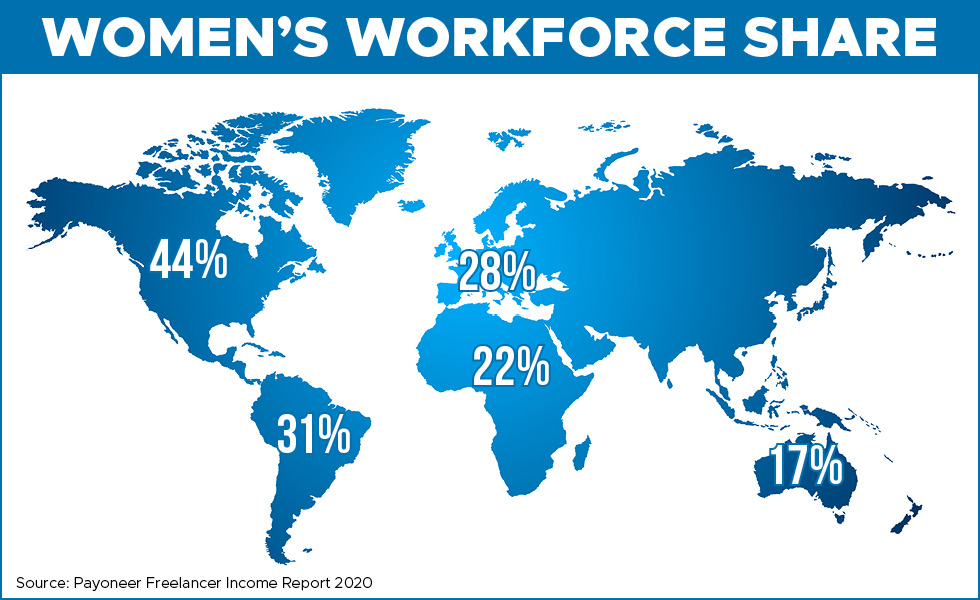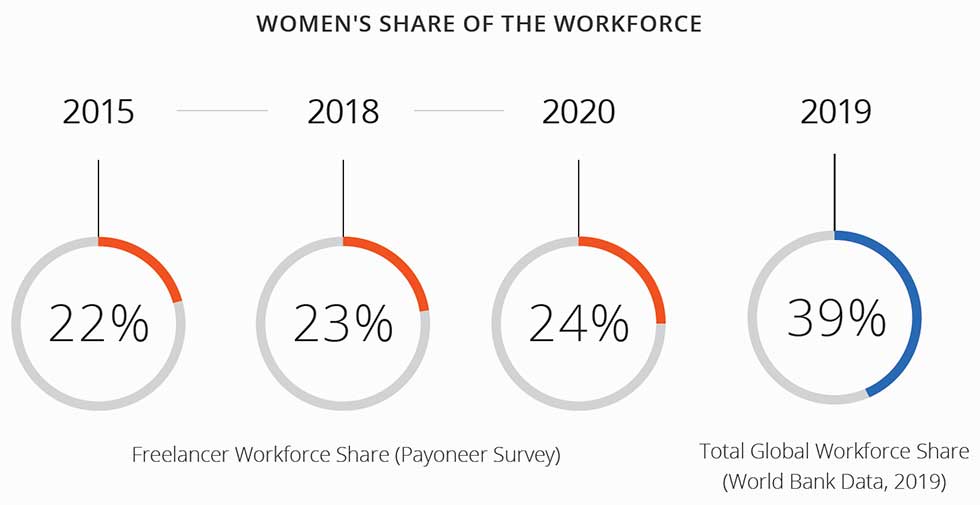It’s not hard to realize that there is a gap between men and women freelancing. Even those who don’t work remotely can spot many differences. If you have been asking yourself – are men and women equal in freelancing, or better said – why not, continue reading this article because we will analyze everything related to this topic.
39% of freelancers worldwide are women
Since the beginning of freelancing, men have definitely been more into remote work. Statistics show us that men who have decided to choose freelance over their regular jobs achieved higher salaries, which is not always the case with women freelancers. Women went remote due to some other benefits, like staying at home, being a work-from-home mom, having enough time to manage housework and her own career, taking care of the family yet to have time for herself, etc. It’s no secret that women today still do more housework than men, especially everything related to children.
Freelancing in different fields
Why do women have lower salaries than men even in the freelance world? Actually, we can “blame” the fields in which they work.
Of course, men can earn more money because they usually work in higher positions, as well as complete tasks that require a lot of education, like programming for example.
Women freelancers mostly work in translation (50%), administration (46%), content writing (43%), customer support (43%), and project management (36%).
Men still have more flexibility in freelance
Men achieve financial stability easier due to the fact that they can accept various remote work circumstances. For example, it may be hard for a woman with a baby to accept a night working shift, and for a man freelancer, that usually doesn’t bring any boundary. It seems like how the main reason for this gender freelance salary gap is related to woman’s role in society. Another “problem” is working fields in which women participate.
Related Posts:
Analysts claim that there is also an issue with protection. Numerous freelance and remote opportunities lack legal, social, and financial protections. All of that can lead to decreased hourly rates among women, despite the same level of education and experience.

Freelancers in different countries face different issues
Of course, everything we’ve mentioned cannot be applied to the entire world. We see that this gender freelancing gap is about to close, or at least – it’s improving in some parts of the world.
North America has a 44% women’s workforce in the freelance industry. The freelancer income report from 2020 also shows us that female freelancers are earning 64% of the men’s hourly rate in all remote and freelancing fields. In South and Central America, 31% of the freelance workforce are women, while in Europe that number is 28%.
In Africa and the Middle East, 22% of women are in the freelance business.
Setting up a freelance business
According to the OECD, women who are trying to set up a business definitely attract less funding than men. It’s no secret that female freelancers usually have lower levels of capital as well. Women freelancers are also more reliant on insider financing than men. All that creates a conclusion that women freelancers and remote workers maybe don’t even get the same chances to succeed.
The future may be brighter for women freelancers
Because there weren’t that many women in the freelancing world, many probably didn’t even try to solve all the issues women freelancers are facing today.
Luckily, with more women going remote each and every day, changes can be expected.
When we take a look at the statistics that talk about the women’s share of the freelance workforce, we can see that the total global workforce in 2019 was 39% In 2015, 22% of women were in the freelance force, 23% in 2018, and 24% in 2020.
Payoneer claims that women freelancers have made a lot of progress
Payoneer’s blog has also covered this gender gap freelancing topic, and they claim that a lot has been done for gender equality in freelancing, yet there’s more to do.
A woman freelancer has an average hourly rate of $16, while a man freelancer has $20.
Payoneer claims that besides everything we’ve mentioned here, they also blame behavioral issues. For example, it’s said that women are still not confident enough to ask for higher salaries. Men, when rejected, they just negotiate, while women freelancers even think about quitting the entire project.
The gap is most noticeable in IT and programming.

Poverty makes the freelancing gap even bigger
Payoneer has also claimed that poverty issues may be the ones to blame for the freelance gender gap. For example, if we take a look at the Philippines, we can see that their women freelancers offer very low prices, which definitely affects all other freelance women worldwide, that work in the same fields.
The problem is also that many women don’t have an education that would bring a higher salary, but they rather are self-learners. Why are they self-learners? As mentioned above already, men today still have more chances than women to educate themselves.
The solution to everything would be working on confidence. As we have already said in this article, the main issue for women freelancers is when they are not paid equally as men but have the same work experience and knowledge as men.
For freelancing women in other fields, such as translation, VA, or writing, it is a must to constantly work on their career, with the purpose to offer more, if they didn’t have enough time for education.
For women freelancers who are stay-at-home moms, pregnant, or have too much housework besides freelancing, advice would be to focus on what’s important for them and to create a balance.
Of course, we should still continue to talk about equality in general, rather than just the financial gap in freelancing work, and work in general.
Men should get included in housework as much as women, and they should take care of children as much as women.
Yet, a lot has to change, not just the hourly rate…
Freelancing platforms and companies should also think about protecting women when they are insensitive during periods of their lives, such as when they are pregnant.
Women freelancers should focus on these 3 key things if they want to reach equality in freelancing and remote fields:
–Charge as much as your male counterparts do. Don’t be afraid to charge as your male freelance colleagues.
–Don’t settle for less. Yes, you may lose that one client, but you’ll find others that will pay you better – which will bring a huge positive change in a short period of time. This way, women freelancers can improve their status on a long-term basis.
–Be sure that you are constantly learning new skills and improving. Learn new things and offer new things, do different tasks that require higher levels of skills. This way, you’ll not only get paid better or later – work less for more money, but you will also build strong confidence, which is the key to everything.
If every freelancer woman would read this and try to achieve this, we would be soon able to see a huge change that would close the financial gender freelancing gap.





